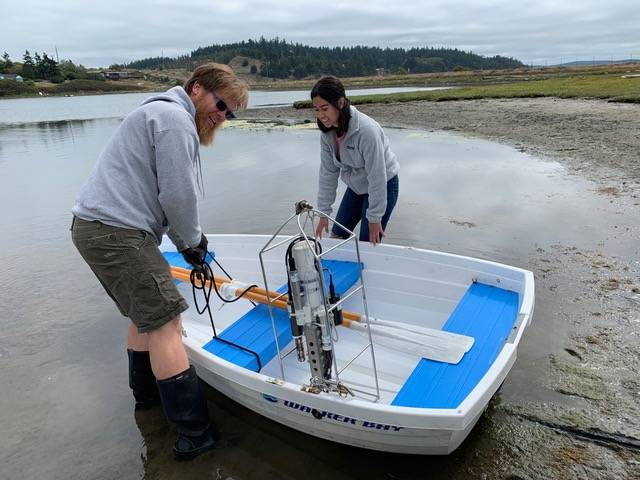Submitted by Salish Sea Sciences
When Kristy Kull of the University of Washington’s Friday Harbor Laboratories took a close look at the data, we all breathed a lungful of relief. A pH of approximately eight inside Argyle Lagoon by Jackson Beach does not mean ocean acidification is going to dissolve our habitat — at least not today — but could it be a predictor of Nobel Prizes?
It all started this last summer when two high schowaters of Argyle Lagoon, a study first conducted by three scientists at FHL in the summer of 1927. When Ayla and Camden’s initial sampling of multiple locations and depths near the lagoon resulted in shockingly low pH levels, possibly due to faulty equipment, they enlisted the latest technology, a Seabird 19plus V2 SeaCAT Profiler CTD custom engineered for FHL by Kull. Equipped like a Ghost Buster, Ayla headed out on Aug. 7 — 92 years to the exact day and time of the 1927 study — with science mentor Derek Smith.
The new surface readings were still low. Our herring should be pickled!
This is where Kull’s thoughtful review of the data comes in. In different locations around the islands, at different depths, during different tides, and at different times of the year pH levels vary widely. Thanks to Kull’s closer look, the new readings fell within expected parameters for the sampling date, fortifying Ayla and Camden with the knowledge that, while their data are not signs of the end of the sea as we know it, the baseline pH has indeed decreased since 1927.
Ayla and Camden are diving deeper into the data analysis to determine how much salinity and other aspects of water chemistry have changed since 1927. Why is the pH aberrantly high at the surface while remaining consistent with historical levels at the bottom? How do the Frasier River, summer heat, and tidal currents fit into the chemistry of our great inland ocean?
Ayla and Camden’s ongoing research is just one of 17 unique pilot projects initiated this summer by high school students from around the world to attend Salish Sea Sciences’ intensive month-long residential marine field and lab research program. Mentored by Salish Sea Sciences Interim Science Director, Derek Smith, Associate Anna Gaskill, a recent graduate of Wellesley College, and the amazing researchers at FHL, SMRU Consulting, and SeaDoc, students bonded over a shared love for the ocean and for science, and in the process gained career awareness, knowledge, skills, and self-confidence. To learn more, visit salishseasciences.org.
The impact is a lasting one. Sabrina Chu from cohort 2018 was so taken by the necropsy performed by Joe Gados of SeaDoc Society that she is starting college at UC Davis this fall, hoping to establish a career as a wildlife veterinarian! Gabi Hoff (Cohort 2017) and Ken Kawamoto (Cohort 2018) are now attending the UW with an eye on the new Marine Biology major—and Friday Harbor’s Eric Sable is pursuing an Environmental Science degree at Western. Our first student to graduate from college has been devoting her life to whale research. Lisa Youdelis was part of the Whale Museum’s Soundwatch team that doggedly tracked the tragic end of Tahlequah (J35) and Scarlet (J50) in the summer of 2018.
Other students, hailing mainly from public schools across the country have gone on to schools including UC Santa Barbara, Seattle University, USC, Duke University, Rensselear Polytechnic Institute, and the University of Southhampton. All have stories of how their Salish experiences catapulted them forward—whether specifically in marine-related pursuits, in the life sciences, medical science, or as environmental and software engineers.
We are tremendously proud of Salish Alumnae and 2019 FHL Young Investigator Prize winners Clarissa Felix and Rachel Snow. Congratulations Clarissa and Rachel! As Seniors, their dedication to marine science will be setting the pace at Friday Harbor High School.
San Juan Islands, we couldn’t do any of this without you. Our program depends on collaboration, and we are profoundly grateful for the engagement of science mentors at FHL and SeaDoc as well as the participation of the US National Parks Service, Whale Museum, Kaigani Canoe Voyaging, and many others. Thanks also to The Northwest Maritime Center, our partner providing students with life-changing expeditions throughout the Salish Sea. Spring Street International School is part of our origin story and continues to provide teaching facilities and a student residence. And, San Juan Community Foundation! Your unswerving support is why we can exist. Thanks to you, we are now Candidate Members for accreditation and STEM certification through Cognia—a nationally and internationally recognized accreditation body.
Our community grows amazing students, and local scholarships change lives. Thank you Lauren and Bob Levinson, The Women’s Fund, The Soroptimists, Luxel Corporation, Marc Islam and Julie Packard, Kelly and Brent Snow, Jenny and Todd Roberts, Carolyn Haughen, Betsy and Chris Pope, Megan Dethier and David Duggins, Pauline and George Mulligan, Susan and Anthony Mazzarella, Liz Covert and Denis Goudie, Rita Pampanin as well as our Salish alumni and families.



